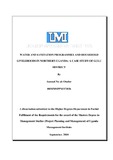| dc.contributor.author | OTEDOR, Samuel Noah | |
| dc.contributor.author | Anukur, Bois Luther(Supervisor) | |
| dc.contributor.author | Namanya, Anaclet M.(Supervisor) | |
| dc.date.accessioned | 2017-07-21T12:55:39Z | |
| dc.date.available | 2017-07-21T12:55:39Z | |
| dc.date.issued | 2010-09 | |
| dc.identifier.citation | APA | en_US |
| dc.identifier.other | 08/MMSPPM/17/026 | |
| dc.identifier.uri | http://hdl.handle.net/20.500.12305/206 | |
| dc.description | A Dissertation submitted to the Higher Degrees Department in partial fulfillment of the requirements for the award of the Master’s Degree in Management Studies (Project Planning and Management) of Uganda Management Institute | en_US |
| dc.description.abstract | The purpose of the study was to determine the contribution of water and sanitation programmes on household livelihoods in Gulu district of Uganda. The study employed a cross sectional survey design and used both qualitative and quantitative techniques in data collection and analysis. The findings revealed that access to water had the greatest contribution towards Household livelihoods in Gulu district, with a correlation of 0.280** and a regression Coefficient of 0.230, which meant that access to water affects the variations in Household livelihoods by 23%. Safe sanitation followed with a correlation of 0.210* and a regression Coefficient of 0.141, implying that its effect on Household livelihood was 14.1%. Livelihood strategies had the least contribution, with an insignificant correlation of 0.133 and a Coefficient of 0.024, implying an effect of 2.4% of the variations in Household livelihoods. In Gulu district households engaged in activities that depend on availability of water which have led to increased incomes and wealth thus improved livelihoods. Households that engaged in safe sanitation had good health and this enabled them to engage in productive activities such as trading and agriculture that notably increased their incomes. The livelihood strategies adopted, given their diversity had an insignificant moderator effect on the relationship between water and sanitation and household livelihoods. Based on those conclusions, the researcher came up with a number of recommendations among which were that; designing of water interventions should be above cooking and drinking needs; communities should be given an active part in the choice of the design, basic treatment and service of water and sanitation related projects and interventions; sanitation programs should enhance the individuals’ well being; water systems design should be made suitable to match the different livelihood strategies and also create awareness to demand for water supply services. | en_US |
| dc.language.iso | en | en_US |
| dc.publisher | Uganda Management Institute | en_US |
| dc.subject | Water and Sanitation | en_US |
| dc.subject | Household Livelihoods | en_US |
| dc.subject | Gulu District | en_US |
| dc.title | Water and Sanitation Programmes and Household Livelihoods in Northern Uganda: A case Study of Gulu District | en_US |
| dc.type | Book | en_US |

